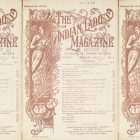The Polyphony of The End of Vandalism

In 1994, with the New Yorker serializing sections of his soon-to-be first novel, The End of Vandalism, Tom Drury—born in Swaledale, Iowa, a town with a population of around 200 at the time—seemed destined to rocket to literary stardom alongside contemporaries Dave Eggers, Jonathan Franzen, and David Foster Wallace. Things didn’t quite pan out. Though The End of Vandalism would eventually be hailed as a “masterpiece” and included on GQ’s list of the “Best 50 Novels of the Last 50 Years,” and though Drury himself would be awarded a Guggenheim and called the “modern master” of depicting an “off-kilter” American Midwest, his work never achieved the kind of commercial success his early resume seemed to foreshadow. In 2015, the Independent called Drury’s persistent obscurity a “literary tragedy.”
Like those of many neglected writers whose names hover perpetually about the threshold of becoming currency at writers’ conferences and MFA programs (a threshold that the Independent seemed, in 2015, hopelessly optimistic that Drury would soon cross), discussions about Drury’s work often begin and end with diagnoses for the disease of this obscurity. The most common explanation is captured wonderfully by The End of Vandalism’s 1994 misfire of a review in Kirkus Reviews:
There’s an awful lot here to like: the dialogue, the sly humor, the feather-light touch, the clean drive of the prose. All Drury needs is a plot for his work to really take off.
Dismissing Vandalism for its plotlessness both misses the point of the novel altogether and homes in on precisely why we may need the book now more than ever. It’s also somewhat forgivable, because it relies on defining “plot” according to the terms of the type of narrative structure that Drury shirks, and that is vastly the most traditional and popular variety, at least in the west.
In The Art of the Novel (1986), Milan Kundera terms this predominant style of fiction “unilinear.” Unilinear works, from the Homeric to the whodunit, produce meaning and narrative tension based upon causally related events arising along a primary, necessarily linear storyline. In other words, events precipitate other events, and the plot effectively snowballs, gaining momentum toward some inevitable base of the hill. Just as discovering whoever is blackmailing Carmen Sternwood only concerns a reader because they’ve unraveled the mystery alongside Philip Marlowe (a narrative only interesting or comprehensible because each clue begets the next), Odysseus’s climactic return to Ithaca is meaningless absent the epic journey that comes before. Subplots, branching off the primary, are subservient to the central narrative: while Huck and Jim’s journey down the Mississippi entails various episodes of onshore hijinks, each side “stream,” so to speak, proves in the end to only be a tributary, running back into the river of the larger narrative. Why, for example, would anyone care that Huck lies about Jim’s supposed smallpox to passerby slave-hunters if it didn’t make Jim’s escape seem more essential (increasing the narrative tension) or (advancing a central theme of the novel) reveal the burgeoning moral lucidity in young Huck?
The End of Vandalism succeeds in far less conventional fashion. In fact, maybe the best argument for the book as a neglected classic—at least in contention with its dry comedy and quiet, then startling prose—is its panoramic and uniquely democratic examination of a veritable web of human stories. Unlike the aforementioned classics, Drury’s novel lacks a definite protagonist and, rather than follow the falling dominoes of events, meanders among interconnected, often tangential storylines belonging to the residents of the fictional Grouse County, Iowa, where rumors “come back seasonally, like perennials.” The love story of Sheriff Dan Norman and photographer’s assistant Louise Darling occupies more pages than any other storyline, but no less authorial respect is heaped on the story of tax evader Colette Sandover, or that of Lu Chiang, a high school exchange student from Tai Wan; or gambler Larry Longhair; or Russell Ford, the county supervisor who must appear before the wildlife court judge when he accidentally shoots a great blue heron. As the British novelist Jon McGregor captured nicely, in The Guardian, while the novel may not adopt a traditional plot, certainly there’s an awful lot happening here:
These stories are the novel’s subject and its method. We move through the book, from scene to scene, character to character, location to location, by way of story: stories told, stories lived, stories hinted at . . . if you live in the real world, where life stalls and lurches forward with little real pattern and where the textures of our relationships accumulate moment by moment, then this is a novel you will recognize as being crammed with narrative. These are not just quirky rural anecdotes Drury is spinning out for us. These are intricate, interconnected stories of the big things that happen in people’s lives; the failures and successes of relationships, businesses, and families, the making and thwarting of plans.
Indeed, whenever narrative satisfaction seems forecasted in the lives of Drury’s characters, it is quickly thwarted, often by nothing more than the banal happenstances that populate real life. Dan and Louise’s honeymoon is shipwrecked by an earache. Joan Gower, aspiring actress turned doorstep proselytizer, runs out on the newly stable family she seemed to desire. Young Albert Robeshaw’s romance with Chiang is doomed by the fact that Chiang must, of course, go back to Taiwan. The heron is shot out of the sky. Practically the only character to have anything resembling an adventure—Dave Green, a realtor and amateur pilot who flies to Hawaii—does so only by accident.
Perhaps The End of Vandalism’s obscurity can be attributed to this reliance on multiple stories, however beautifully drawn they may be. After all, the books that made famous Eggers, Franzen, and Foster Wallace don’t employ the approach, nor do any of the books that have popularized their authors overnight in more recent memory—from Normal People to Swamplandia! to The Sympathizer. In fact, pouring over lists of the best-selling, best-recognized literary novels of the last few decades, Jennifer Egan’s A Visit from the Goon Squad exists as a rare exception to the rule that we tend to prefer the more straightforwardly threaded unilinear novels to the loosely knit, frayed kind advocated by Drury.
Kundera’s identification of nonlinear, multinarrative stories opposite unilinear tales may help explain this phenomenon. Kundera defines “polyphonic” novels as those that rely instead on multiple, thematically united narratives to compel the reader. Paraphrasing Russian literary theorist Victor Shklovsky, Kundera suggests that by packing multiple stories of varying genres inside the “box” of the novel, a work can achieve a kind of polyphony akin to an orchestra’s arrival at a symphony by the joined force of multiple, balanced instrumental sections. Like this necessary instrumental balance, Kundera argues that polyphonic fiction relies on an “equality of voices” in which “no one voice should dominate, none should serve as mere accompaniment.” Rather, they should be “perfectly bound together but still keep their relative independence.” Kundera cites Don Quixote as an early example. Whereas Huckleberry Finn’s onshore vignettes function, fittingly, like tributaries—important only insofar as they will eventually rejoin the river of the novel’s central narrative thread—Kundera notes that the people Alonso Quixano encounters along his journey, though it may itself be linear, tell their own stories, stories “embedded” within the larger narrative that, causally unrelated to the central quest, “allow us to step outside the novel’s linear framework.” To beat what life remains out of our river metaphor, Cervantes’s “streams” are the distributaries to Twain’s tributaries—they need never rejoin the larger channel; they are rivers in their own right, and can, despite their physical (read: causal) separation, speak to the nature of rivers. It is because of this narrative structure that Kundera (mirroring McGregor’s claims in The Guardian) believes the polyphonic novel to provide a superior means than the unilinear to “encompass the complexity of existence in the modern world.”
If this is true, and polyphonic novels remain underread nonetheless, then perhaps there is something to the common refrain that we turn to fiction to escape the rigmarole of everyday life—a more common explanation for reading genre fiction about the fantastic than realistic literary novels, but maybe a reflection, too, of why some resist realist (in the most traditional, limited sense) fiction in the first place. After all, why escape to someplace just like where you are?
The question of Drury’s relative anonymity may ultimately hinge on the somewhat mystical question of what we desire of fiction—which is also to ask, inevitably, what we desire of narrative. One compelling answer is provided by socio-linguist Charlotte Linde, who, in her 1993 book Life Stories: The Creation of Coherence, wrote that “[i]n order to exist in the social world with a comfortable sense of being a good, socially proper, and stable person, an individual needs to have a coherent, acceptable, and constantly revised life story.” Linde’s theory of the formulation—and also, importantly, the presentation—of self relies on establishing what she terms an “adequate causality” in which one interprets their life as a chain of causally related events, and wherein one’s sense of self is “subject to expansion and contraction by the addition of new stories and the loss of old ones, and furthermore the reinterpretation of old stories continually produces new evaluations of self.” Linde’s theory gains immediacy when considered alongside William B. Swann and Angel Gómez’s notion of “identity fusion,” wherein boundaries between one’s perception of self and other become blurred, allowing the latter to subsume the former. In essence, it’s an extreme version of the kind of identity overlap we experience as a product of everyday social associations, but fusion seems most likely to occur with charismatic, authoritarian leaders, and can make individuals more likely to make extreme choices, like committing acts of violence, inconsistent with our typical identities. If Linde establishes that one’s self perception is established based on a satisfying narrative account of one’s life, then identity fusion could be taken to suggest that others’ stories factor heavily into the development of one’s own.
I grew up in the Midwest, in the Driftless area of Drury’s imagined Grouse County, and political trends of the last few years have led me to worry that Midwestern imaginations may be uniquely vulnerable to a kind narrative-oriented identity fusion akin to what Chimamanda Adichie calls “the danger of the single story.” For one, perceptions of the Midwest entertained by locals and interlopers alike often center on a sense of the region as the “common denominator” of America, an assumption that can be traced from its roots in the work of sociologists Helen and Robert Lynd, to politicians’ frequent choice to emphasize their midwestern origins when playing up their folksy centrism, to the emergence of the “General American” accent—all of which are nicely encapsulated by the region’s sometimes nickname: the “heartland,” a designation relying as much on caricatured demographics (that is: white, middle class, Christian) as it does on the insinuation that Midwesterners themselves represent the utopic American mean for which others ought to strive. Michigander Phil Christman writes:
Because it attracts us, normal-ness becomes a fetish, a performance, or a product. The Midwest, because of its perceived averageness, has long been forced to play a symbolic role . . . [but] normalcy is also alienating. I meet many Midwesterners who seem honestly to believe that their experiences are too banal for description . . . you often hear a kind of general regret, a sense of having missed something, having blown a chance.
Linde’s theory of identity formation seems to support Christman’s observations. If one arrives at a coherent sense of identity by interpreting life as plot, the concept of the Midwest as a symbol of satisfied inertia would stand at odds with its citizens’ basic psychological desire to shape stories out of their lives, or at least stories that seem worth telling. And this is key, because captivation is the currency of story. Believing one’s own story to be worthless leaves one vulnerable to those who might come along and say it isn’t—that it does, or could, have value, well-intentioned or not. Gentle parents do this when they tell you you’re doing just fine, as does the warlord who comes along with a gun and cool scarf and says, “Hey kid, you want to be somebody? You want to make a good story out of your life?” In this context, good—as in, “Wasn’t that a good movie?”—shouldn’t be taken as a moral metric, but a measure of significance. For the Midwest, in 2016, the person who came along was Donald Trump, a Manhattan billionaire who quickly and somewhat puzzlingly came to represent “an image of [the] aspirations” of, in particular, white men in the region’s rural swaths. But Trump campaigned on the simple notion that the self-perception of his to-be supporters, inseparable from their perception of the world, was, echoing the myth of the heartland, the best. Which is to say, important. This justifies—even makes an injustice out of—any misgivings one may have had about any previously perceived insignificance of their personal story. Finally, one thinks, someone understands me, sees the world the way I do, and suddenly the soil is fertile for the identity fusion that Swann and Gómez describe.
Perhaps all this circles back to happenstance or privilege—to whether and when one’s life story is validated by the malicious versus the well-intentioned. But in The End of Vandalism, this dilemma doesn’t exist. In its polyphonic, sympathetic depiction of characters sometimes succeeding, sometimes not, with ambitions big, small, and short-sighted, and flaws nagging and fatal alike, all lives exist as equal comments on the theme, so to speak, of life. As Yiyun Li writes: “Drury’s rare achievement is to populate a novel with a group of life-sized nobodies.” That, in essence, is why we need Tom Drury’s work: it is an argument that no lives are too banal to be beautiful, and certainly, too, that stories shouldn’t go unheard on the basis of their present obscurity or variation from normative form.



